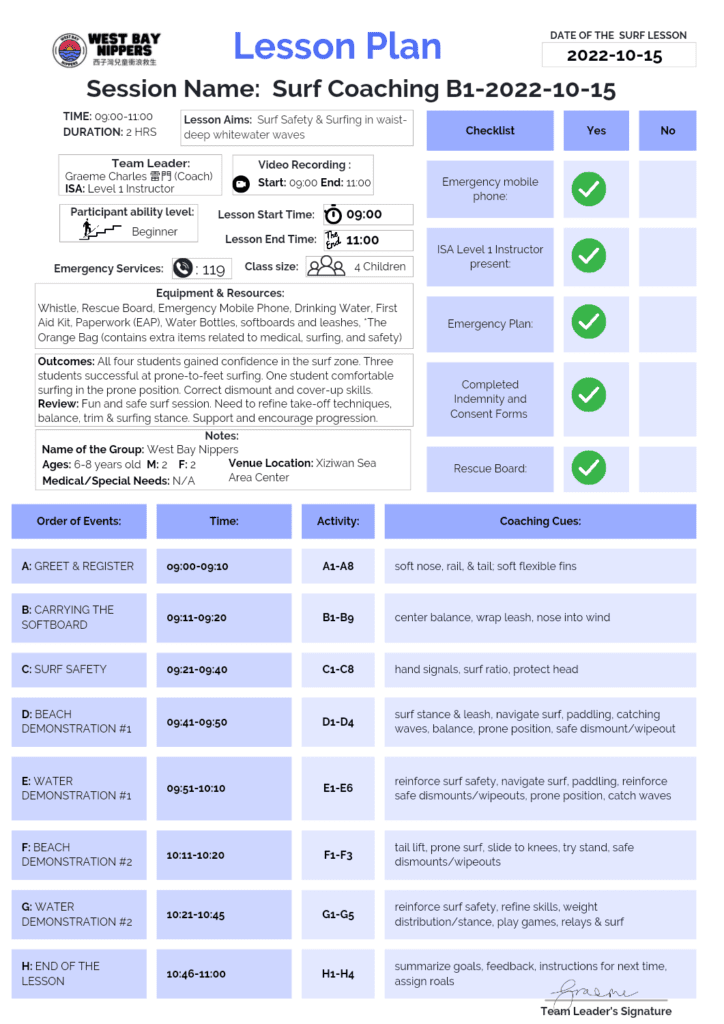
A: GREET & REGISTER
A1: Introduction
A2: Collect completed signed indemnity and consent forms, and sign in
A3: Explain the aims for the day’s surf lesson, Code of Conduct, and surf safety ratios
A4: Set and explain physical surf lesson boundaries and establish landmarks
A5: Check for appropriate swimwear
A6: Distribute high-visibility yellow rash guards
A7: Explain the parts of the softboard and the usefulness of other resources
A8: Demonstrate one-person & two-person board carry
Safeguarding Children: Physical Contact
Beach and Water Demonstrations
B: CARRYING THE SOFTBOARD
B1: Hand out suitable-sized softboards
B2: Demonstrate how to place the board on the beach
B3: Pick up the softboard and find the center balance
B4: Wrap the leash around the softboard to avoid dragging it behind you
B5: Carry the softboard efficiently and safely
B6: Point the nose of the softboard into the wind
B7: Assist each other in the “double board carry” method
B8: Proceed safely to the beach locationB9: Reinforce how to carry the board and place it on the beach
C: SURF SAFETY
C1: Warm up and stretch
C2: Explain and practice emergency recall and assistance required signals
C3: Explain the weather, surf conditions, potential hazards
C4: Reaffirm physical surf lesson boundaries and establish landmarks
C5: Check the water safety ratio for swimming activities
C6: Staying in waist-deep water – practice surf safety skills:
- Safely entering and exiting the water
- Standing and navigating through whitewater waves
- Diving over or under whitewater waves
- Bodysurfing waist-deep waves
- Treading water and floating
- Rip Current Survival Plan
C7: Complete the swim and float test
C8: Break & Refreshments
D: BEACH DEMONSTRATION #1
D1: ESSENTIAL SKILL 2: NAVIGATING THE SURF ZONE
Before entering the surf zone, the coach must teach the students to put the leash on the correct foot, secure the velcro with a tight but comfortable fit, and have the cord positioned at the back of the ankle.
The coach must explain and demonstrate the correct methods of pointing the nose into the waves, popping the nose of the softboard over the waves, and maneuvering the softboard through the surf zone.
Surfers can attempt to push the softboard with their hands on either rail at the middle of the softboard to waist-deep water, turn around, and catch small suitable whitewater waves.
The surfer can also try holding the nose of the softboard and navigating their way through the small whitewater waves.
D2: ESSENTIAL SKILL 3: PADDLING THE SOFTBOARD
The coach must teach the students to:
- Paddle the softboard efficiently with good control techniques, balance, trim, and tempo
- Lift your chest off the board, keep your head up, and observe what is happening around you
- Keep your hands cupped, fingers together, and paddle with alternating strokes with the elbow slightly bent
D3: CATCHING WAVES IN THE PRONE POSITION
Coaching cues:
- Shift your weight slightly toward the back of the softboard (how to avoid “nose dives”)
- Keep the nose of the softboard out of the water
- Glance over your shoulder to spot the wave
- Paddle powerfully
- As the tail lifts, place your hands flat on the deck directly under your armpits.
- Slightly arch your back and look in the direction you want to go
- Explain how to wipe out safely and cover-up
D4: ESSENTIAL SKILL 6: SAFE DISMOUNTS
The coach must prevent participants from surfing whitewater waves onto the beach and riding the fins into the sand.
The coach must teach:
Dismount the softboard from the prone position
- Control the softboard with a firm grip of your hands on the rails
- Slide your hips off the softboard
- Bring your knees to your chest
- Drag your feet in the sand to act like a break
- Stop the forward movement of the softboard
E: WATER DEMONSTRATION #1
E1: Reinforce recall signal/assistance required signals
E2: ESSENTIAL SKILL 2: NAVIGATING THE SURF ZONE
E3: ESSENTIAL SKILL 3: PADDLING THE SOFTBOARD
E4: ESSENTIAL SKILL 6: SAFE DISMOUNTS
E5: Explain how to wipe out safely and cover-up
E6: Practice catching whitewater waves in the prone position
F: ESSENTIAL SKILL 4: TAKE-OFF TECHNIQUES
F1: The coach will demonstrate three “take-off” techniques to help surfers consistently move from a prone position to their preferred surfing stance.
Coaching Tips
- Paddle with powerful, steady strokes
- Peek over your shoulder to spot the wave
- As the board moves forward and the tail of the softboard lifts, surf the softboard in the prone position or try one of the three take-off techniques.
TAKE-OFF TECHNIQUE A: SLIDE YOUR KNEES
The surfer must:
- Slide both knees forward and onto the softboard
- Bring your front foot forward in between your hands
- Stand up
TAKE-OFF TECHNIQUE B: SLIDE YOUR BACK FOOT
The surfer must:
- Slide your back foot forward onto the softboard just in front of the tail pad
- Lift your upper body off your softboard
- Bring your front foot forward and stand up.
TAKE-OFF TECHNIQUE C: “POP-UP”
The surfer must:
- Use your hands and knees to help you jump up (pop-up) from your softboard
- Move your feet under your body
- Land on your softboard with feet apart and balance your body
F2: ESSENTIAL SKILL 5: SURFING “DOWN THE LINE”
Once the participant can competently stand and ride the whitewater wave straight to the beach, the coach can teach the surfer to:
- Paddle at a slight angle toward the beach
- Angle the softboard across the wall of the wave and use a “take-off” technique
- Focus on the direction you want to go by turning your head, pointing with your leading arm, and twisting your hips toward the wave
- Stand with your knees bent and a straight back.
- Support your body weight over your front foot and spread your arms for balance
F3: ESSENTIAL SKILL 6: SAFE DISMOUNTS
Dismount the softboard from the standing position
- Slow your forward movement by placing weight on your back foot
- Step off to the side of your softboard
- If possible, grab the tail of your softboard
- Bring your knees to your chest
- Drag your feet in the sand to act like a break
- Stop the forward movement of the softboard
F4: WIPEOUTS
The coach must teach participants to fall off the softboard safely by demonstrating this skill on the beach and reinforcing these skills during the surf lesson.
Coaching Tips:
- Fall away from your softboard
- Fall flat (like a starfish) on the surface of the water and try to avoid touching the sand
- Put both your arms and hands out in front of you when falling forward
- Explain how to wipe out safely and cover-up
G: WATER DEMONSTRATION #2
Demonstrate and practice:
G1: ESSENTIAL SKILL 4: TAKE-OFF TECHNIQUES
G2: ESSENTIAL SKILL 5: SURFING “DOWN THE LINE”
G3: ESSENTIAL SKILL 6: SAFE DISMOUNTS
G4: Regroup and repeat sand/surf practice with individual studentsG5: Feedback
H: END OF THE LESSON
H1: Regroup the participants on the beach and summarize the lesson goals
H2: Give recognition and encouragement to the participants and ask for feedback
H3: Provide instructions and resources for the next lessonH4: Assign roles for carrying softboards, packing away equipment, and finally, sign-out
